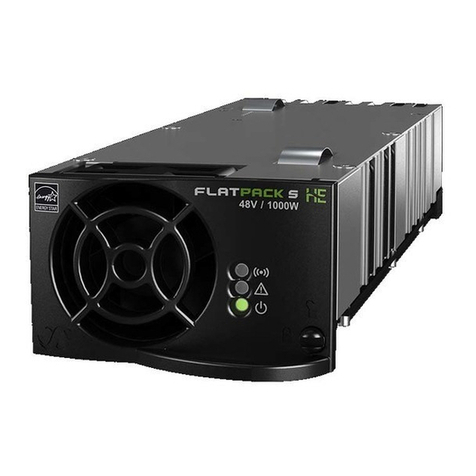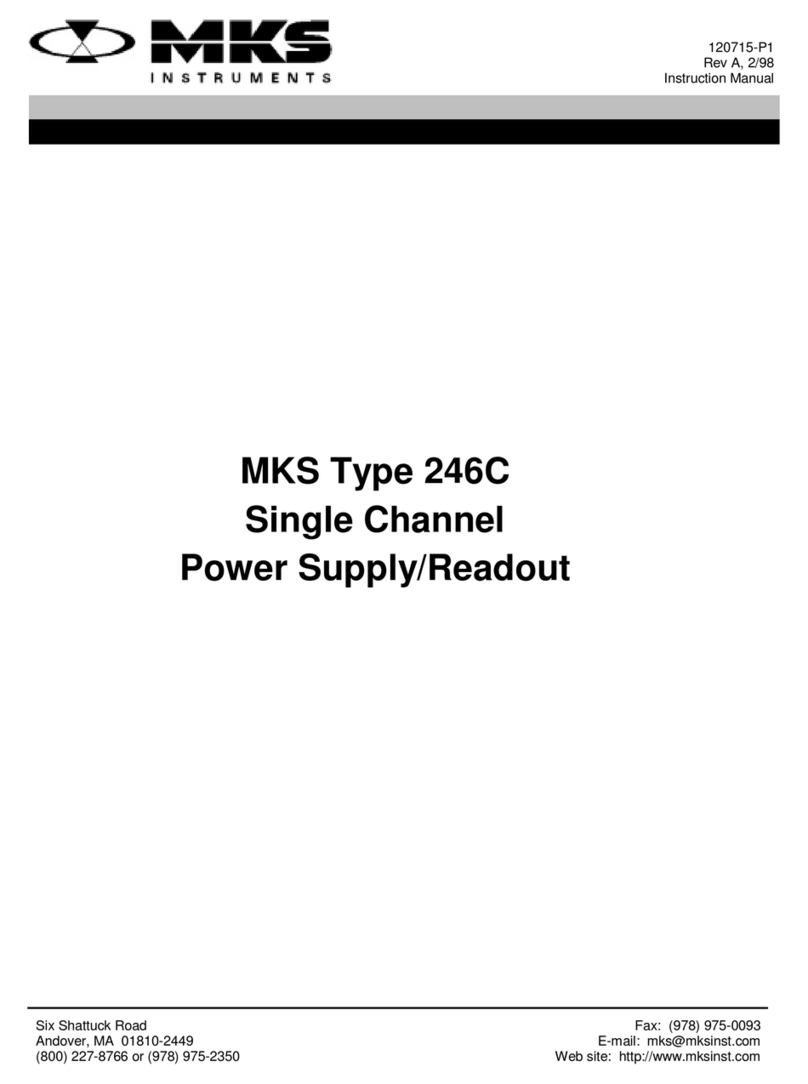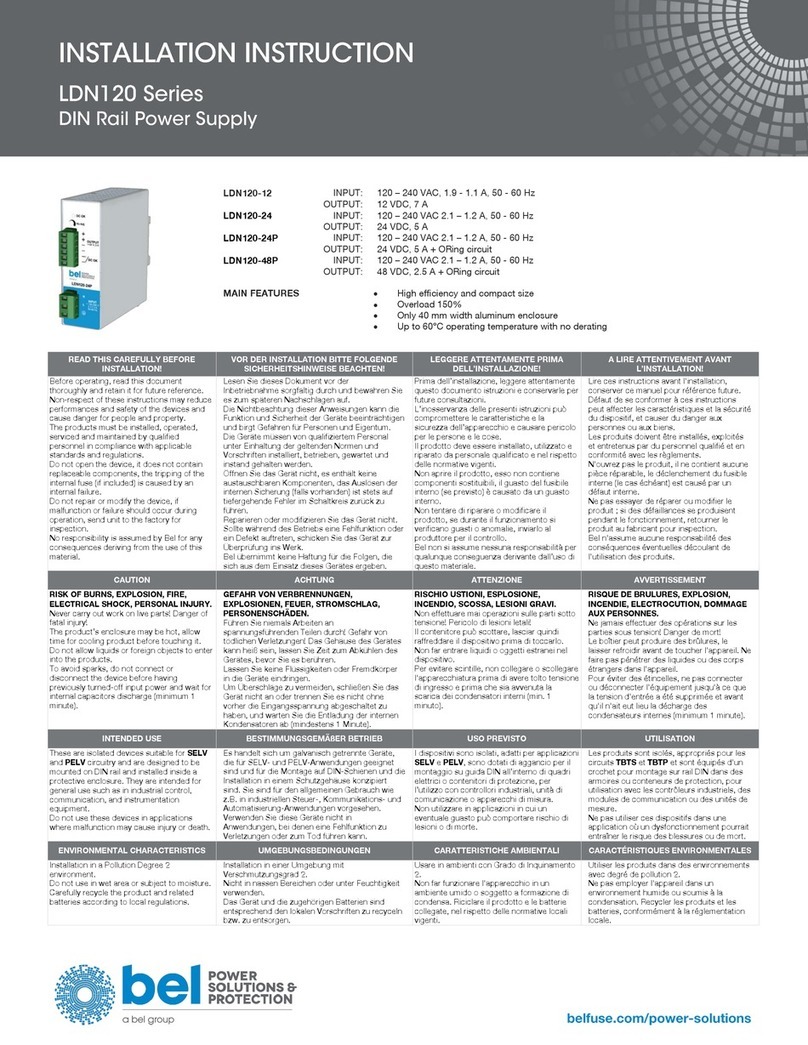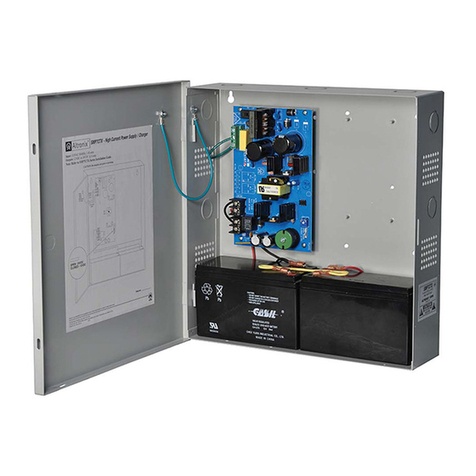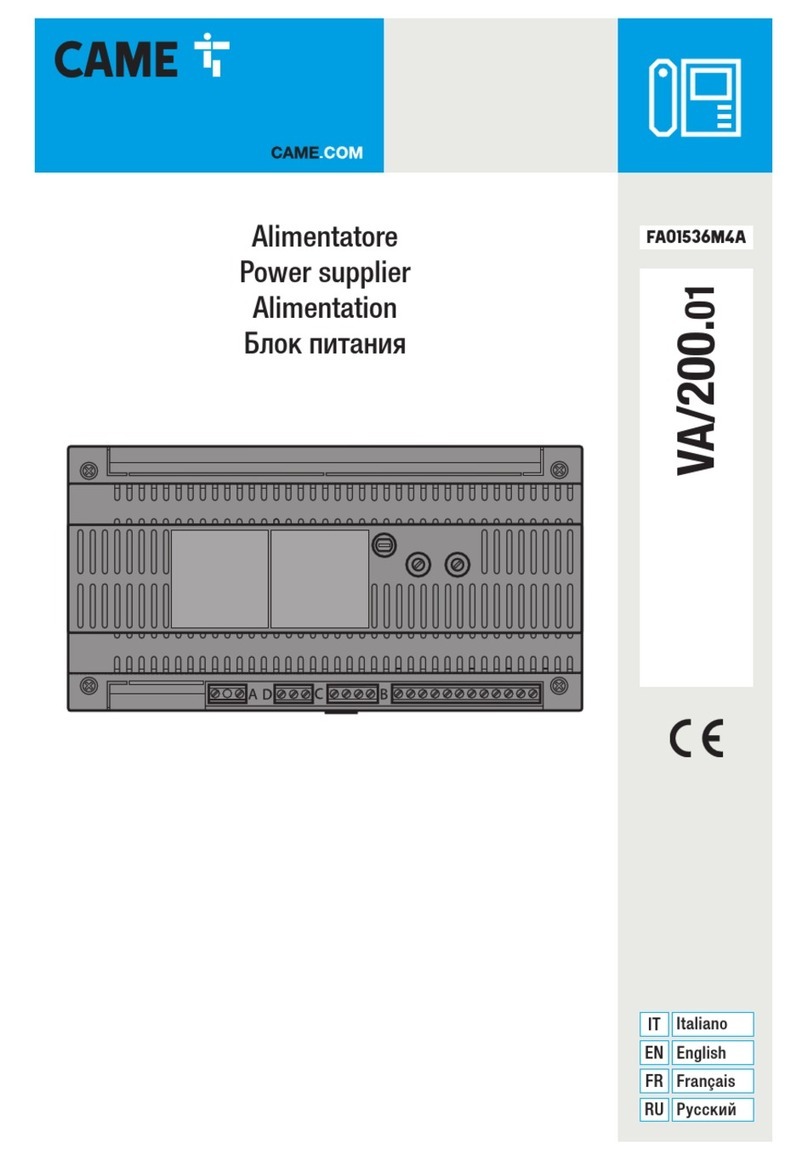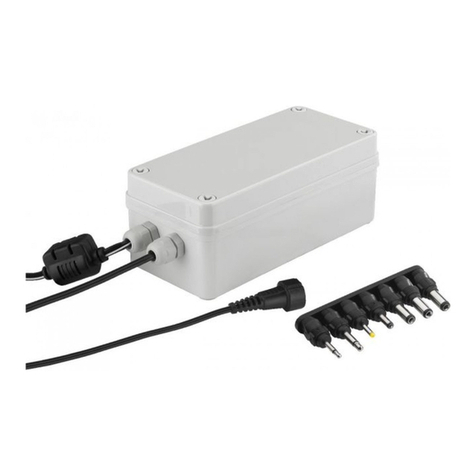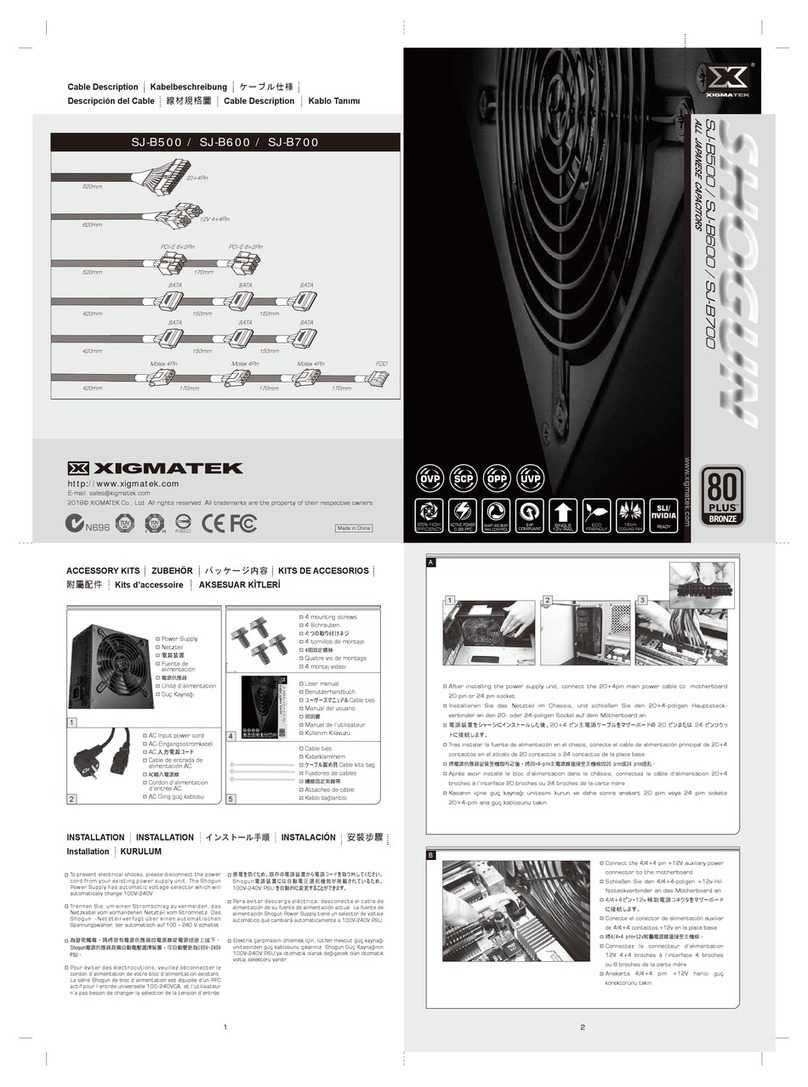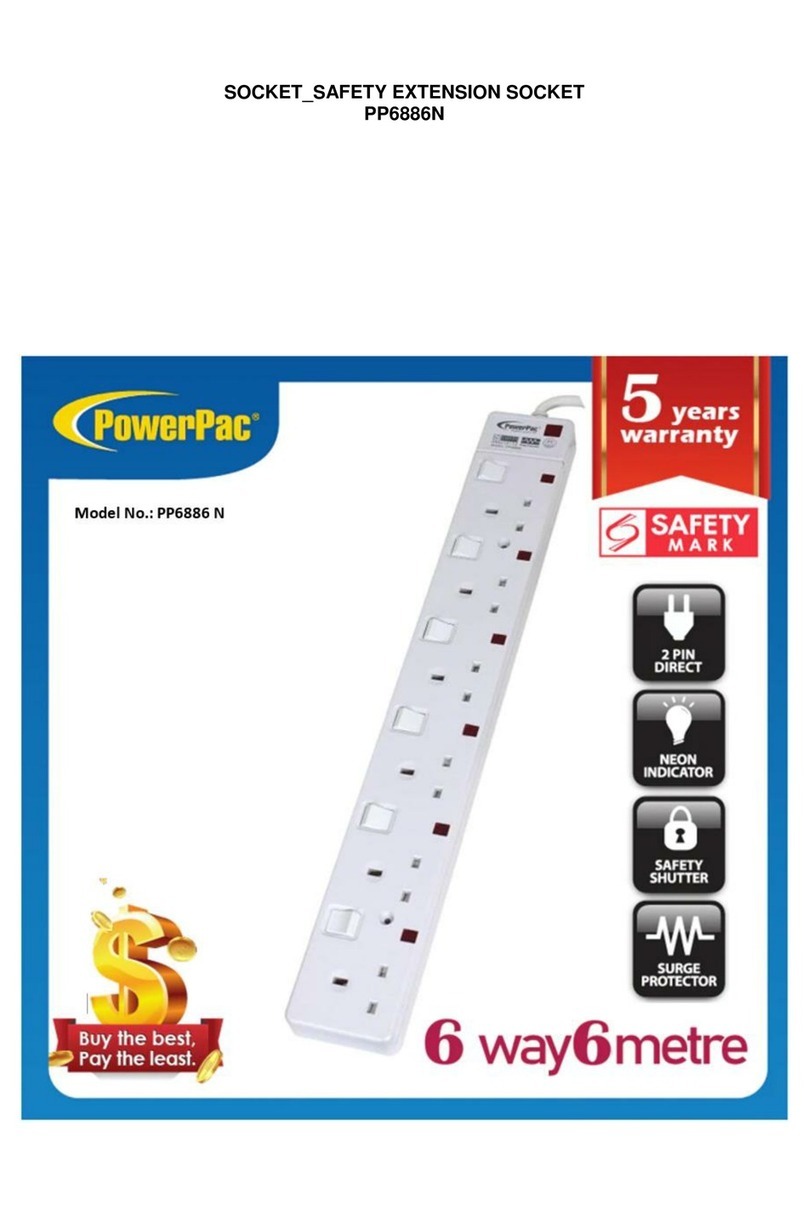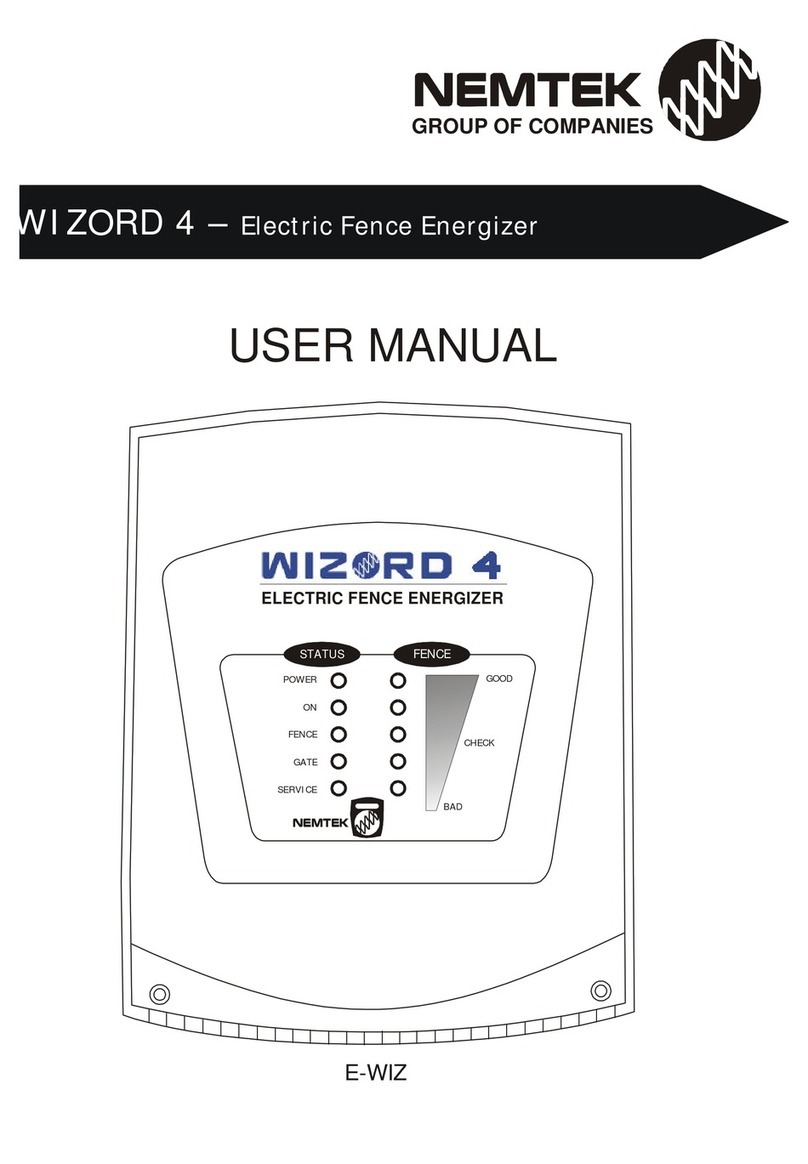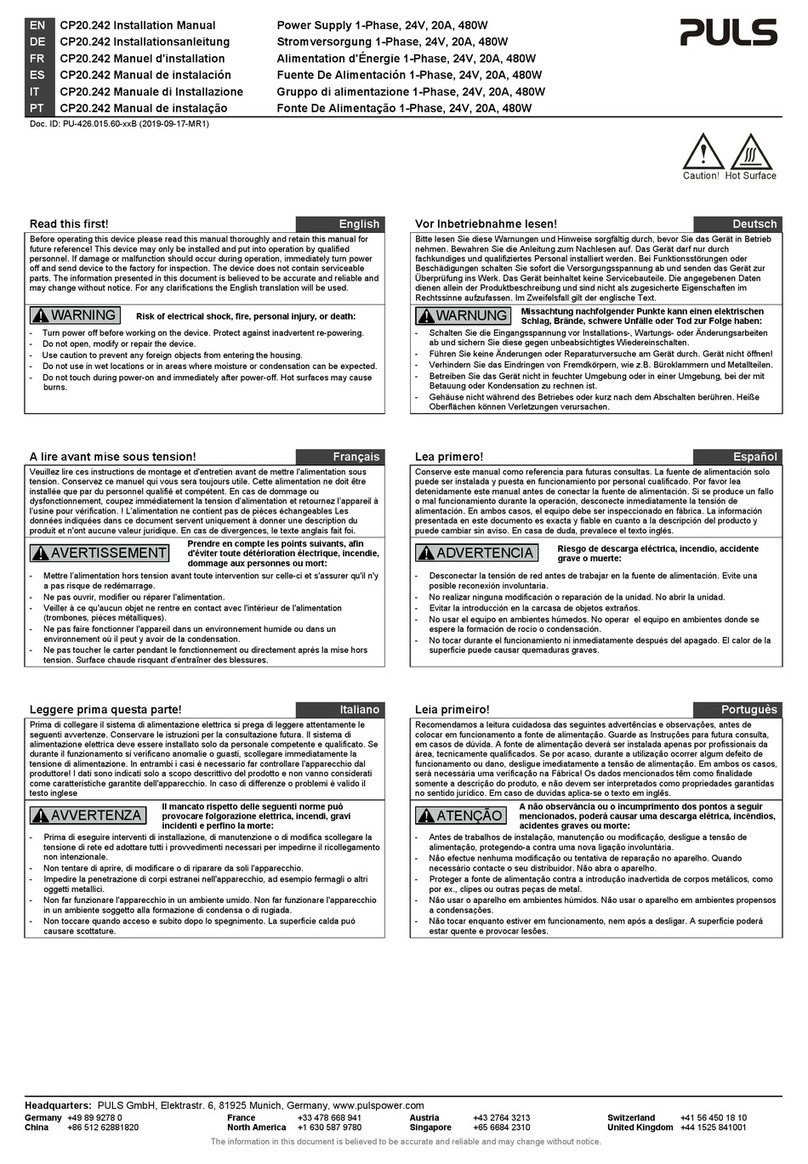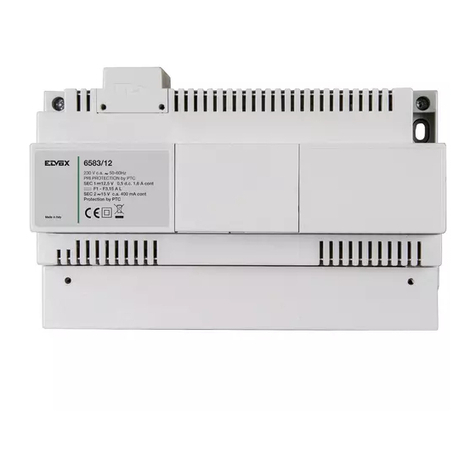G.R.A.S. 12AQ User manual

Instruction Manual
Power Module Type 12AQ
Skovlytoften 33, 2840 Holte, Denmark
SOUND & VIBRATION
G R A S
...
.

Revision 04.12.2019
Power Module
Type 12AQ

G.R.A.S. SOUND & VIBRATION
CONTENTS
1 General Description ..............................................4
1.1 Introduction . . . . . . . . . . . . . . . . . . . . . . . . . . . . . . . . . . . . . . . . . . . . . . . . . . . . . . . 4
1.2 Salient Features ...................................................4
Traditional preampliers ....................................................4
CCP preampliers. . . . . . . . . . . . . . . . . . . . . . . . . . . . . . . . . . . . . . . . . . . . . . . . . . . . . . . . . 4
1.3 Signal Conditioning . . . . . . . . . . . . . . . . . . . . . . . . . . . . . . . . . . . . . . . . . . . . . . . . . 5
Gain ...................................................................5
Input ..................................................................5
Ouput .................................................................5
Polarization voltage. . . . . . . . . . . . . . . . . . . . . . . . . . . . . . . . . . . . . . . . . . . . . . . . . . . . . . . . 5
Preamplier supply voltage..................................................5
Syscheck. . . . . . . . . . . . . . . . . . . . . . . . . . . . . . . . . . . . . . . . . . . . . . . . . . . . . . . . . . . . . . . . 5
1.4 Power Supply .....................................................5
2 External Features ................................................6
2.1 Front Panel . . . . . . . . . . . . . . . . . . . . . . . . . . . . . . . . . . . . . . . . . . . . . . . . . . . . . . . 6
Manual Control ...........................................................6
2.2 Rear Panel .......................................................8
3 Internal Features . . . . . . . . . . . . . . . . . . . . . . . . . . . . . . . . . . . . . . . . . . . . . . . . 10
3.1 Battery Compartment ..............................................10

G.R.A.S. SOUND & VIBRATION
4 Remote Control via RS-232 Interface ...............................11
4.1 Introduction . . . . . . . . . . . . . . . . . . . . . . . . . . . . . . . . . . . . . . . . . . . . . . . . . . . . . . 11
4.2 Interface ........................................................11
4.3 Behaviour .......................................................13
4.4 Commands and Responses .........................................13
Setup Commands . . . . . . . . . . . . . . . . . . . . . . . . . . . . . . . . . . . . . . . . . . . . . . . . . . . . . . . . 13
Special Commands. . . . . . . . . . . . . . . . . . . . . . . . . . . . . . . . . . . . . . . . . . . . . . . . . . . . . . . 16
Special Responses . . . . . . . . . . . . . . . . . . . . . . . . . . . . . . . . . . . . . . . . . . . . . . . . . . . . . . . 16
4.5 Overload Responses ..............................................16
In Latched Mode .........................................................16
In Message Mode (non-latched) .............................................16
4.6 Power-up/down Settings . . . . . . . . . . . . . . . . . . . . . . . . . . . . . . . . . . . . . . . . . . . . 17
5 Service and Repair ..............................................18
6 Specications ..................................................19
7 Optional Accessories . . . . . . . . . . . . . . . . . . . . . . . . . . . . . . . . . . . . . . . . . . . . 21

G.R.A.S. SOUND & VIBRATION
Power Module Type 12AQ
Page 5
1 General Description
1.1 Introduction
The G.R.A.S. Power Module Type 12AQ (Fig. 1.1) is a dual-channel power supply for preampli-
ers (CCP as well as traditional) used with measurement, condenser microphones.
It has facilities for both manual control and remote control. Manual control is via its front-panel
switches and push buttons. Remote control is via its RS232 interface.
The Type 12AQ is for general use in acoustic measurements as well as for intensity measure-
ments; both in the laboratory and in the eld.
Fig. 1.1 The Power Module Type 12AQ
1.2 Salient Features
1.2.1 Traditionalpreampliers
For traditional preampliers such as Type 26AL (¼″) or Types 26AJ and 26AH (½″), the Type
12AQ provides:
• a voltage supply (± 15 V or ± 60 V) for powering up to two microphone preampliers.
• a polarization voltage (200 V or 0 V) for two condenser microphones.
• a SysCheck signal (1000 Hz) for calibration checks.
1.2.2 CCPpreampliers
For CCP (constant-current power) preampliers such as Types 26CB and 26CC (¼″) or Types
26CA and 26CF (½″), the Type 12AQ provides:
• a constant current supply (4 mA) sourced at 28 V DC for two CCP microphone preampliers.

G.R.A.S. SOUND & VIBRATION
Power Module Type 12AQ
Page 6
1.3 Signal Conditioning
Each channel can be set up independently in terms of gain, lter, input, output and polarization
voltage. The bandwidth of the signal conditioner is:
1.3.1 Gain
Type 12AQ has a wide frequency range: the gain can be adjusted in steps of 10 dB from
-20 dB to +70dB.
Frequency response
For gain from – 20 dB to 50dB:
10 Hz to 100 kHz ± 0.1 dB
2 Hz to 200 kHz ± 0.2 dB
For gain 60 and 70 dB:
10 Hz to 20 kHz ± 0.1 dB.
One of a series of front-panel LEDs (e.g. 20 dB) lights up to indicate the current gain setting.
Filter
The lter characteristics (applied to the bandwith of the signal conditioner) can be selected from
one of the following:
Lin for linear response with a high-pass lter of 0.2 Hz.
HP for linear response with a high-pass lter of 20 Hz.
AW for an A-weghted response.
Ext for using a built-in, customised a signal-response network (contact G.R.A.S. for further
details).
Note! The Ext option provides you have installed a customised signal-response net
work (not factory-mounted).
1.3.2 Input
The microphone signal can enter the Type 12AQ via either of the following input sockets on the
rear panel.
BNC sockets for microphones used with CCP preampliers
7-LEMO sockets for microphones used with traditional preampliers
1.3.3 Ouput
The conditioned output signals, via the BNC output sockets on the rear panel, can be made
available as either oating or non-oating.
1.3.4 Polarization voltage
Applicable to 7-pin LEMO preamplier inputs on the rear panel. Can be set to either 0 V or
200 V.
1.3.5 Preampliersupplyvoltage
This can be set to either ± 15 V or ± 60 V. The chosen value will apply to both 7-pin LEMO
preamplier inputs.
1.3.6 Syscheck
This can be set to either SysCheck signal (1000 Hz) on or off. The chosen condition will apply to
both 7-pin LEMO preamplier inputs.
1.4 Power Supply
The Type 12AQ can be powered either by internal standard alkaline cells (6 x LR14 {C}) or from
the included mains/line Adapter for either 115 V AC or 230 V AC * .
* A0002 (EU) or AB0003 (USA)

Overload LED: on when
overload present; off
when absent, unless
latched to remain on
after overload.
Filter switch: rotate switch
to make a selection.
CCP Input
Floating Ouput
Polarization 0 V
buttons: LED on only
when function is active,
otherwise off.
Gain LEDs: showing the selected
gain in dB. Rotate switch
clockwise to increase gain and
vice-versa.
SysCheck button: LED
on when SysCheck
active, otherwise off.
On/Off button
Power LED: green on; yellow
standby, otherwise
Battery LED: green on; red low.
Remote LED: when on (manual
switches disabled, except power).
Channel numbers.
Filter LEDs: showing the selected lter.
Lin(Linear)
HP (high-pass)
AW (A-weighted)
Ext(Extension) optional customised
lter.
Latch button: LED on
only when Latch is
active, otherwise off *
Preamp. ±15 V
button: LED on only when
value is set to ±15 V,
otherwise it is ±60 V.
G.R.A.S. SOUND & VIBRATION
Power Module Type 12AQ
Page 7
2 External Features
2.1 Front Panel
Front-panel details are shown in Fig. 2.1.
2.1.1 Manual Control
Manual control is via toggle-buttons and rotary switches. Green LEDs indicate the current set-
tings and red LEDs are overload warnings (Power and Battery LEDs apart).
With the exception of Remote, the Type 12AQ can be manually-controlled via its front panel.
Remote can be selected only via the RS232 interface. Note: when Remote is active, manual
control is disabled (except power off). Only remote control via the RS232 interface is permitted.
Power button
Note: when external power is connected, it will take precedence over battery power.
With external power connected, the Power LED shows:
• Yellow for standby
• Green for switched on
With only battery power available, the Battery LED shows:
• Green for switched on
• Red for insufcient battery power, only when powered on (see chapter 3 for changing
batteries)
Fig. 2.1 Front-panel details of the Power Module Type 12AQ
* Behaviour modied if the latch command has been sent via the RS232 interface.

G.R.A.S. SOUND & VIBRATION
Power Module Type 12AQ
Page 8
Remote LED
Can be selected only via the RS232 interface. When on, all manual switches (except the Power
button) are disabled. Control is only via the RS232 interface. Cancelled either via the RS232
interface or by switching off/on.
Latch button
When activated, Overload LED(s) will remain on after detecting an overload, even after the
overload ceases. Latched Overload LED(s) can be cancelled by pressing the Latch button
once. Press the Latch button once (double push if overloaded) to cancel Latch.
The manual user controlled overload system:
The manual-user overload system can be disabled by the command: Ovlled n.
The system will be enabled on the next power on or by the command: Ovlled y.
Note: The overload system consists of two independent systems, a manual user system and a
remote controlled system.
In non-latched mode:
When the overload detector is in the non-latched mode, the respective overload LED will follow
the overload status, unless disabled by the command: Ovlled n.
The Overload LEDs will light during an overload condition; they will turn off about one second
after the overload condition ceases. This time can be changed via the command: Ovltm m or
by Ovltm #.
In latch mode:
For each of the overload detectors, an LED indicates the actual overload condition. The over-
load LED will be turned on when an overload occurs.
Pressing the latch button while no overload-LED lights will change the mode to non latched.
Pressing the latch button while an overload-LED is turned on and no overload condition is
present will turn off the overload-LED, if an overload condition is present nothing will happen.
To skip out of latch mode during an overload condition press latch button twice within a space
of 0.5 sec.
Gain in dB
Rotary switch for increasing or decreasing the gain of the conditioning amplier of this channel.
Rotate clockwise to increase gain or anti-clockwise to decrease gain. The range of gain settings
is from – 20 to 70 in steps of 10 dB.
Filter
Rotary switch for selecting the signal response of the conditioning amplier for this channel.
There are four settings, the rst three can be selected manually via the rotary switch, these are:
Lin for linear response with a high-pass lter of 0.2 Hz.
HP for linear response with a high-pass lter of 20 Hz.
AW for an A-weighted response.
Ext for an optional built-in, customised signal-response network
(contact G.R.A.S. for further details).
CCP Input button
When activated, the incoming signal for this channel is expected via the corresponding CCP
Input socket (BNC) on the rear panel. When cancelled, the incoming signal is expected via the
corresponding Mic Input socket (7-pin LEMO) on the rear panel.

Two Inputs for CCP
Preamplifers with pre-
polarized Microphones
Two Inputs for Pream-
plifers with externally-
polarized Microphones
Signal Output for
Channel 2
RS232 Control
Input for external
power supply 8 - 18 V
DC
Locking screw for
base plate
Signal Output for
Channel 1
Channel numbers
Adjusments for
Preamplifers with
SysCheck facilities and
externally polarized
Microphones.
G.R.A.S. SOUND & VIBRATION
Power Module Type 12AQ
Page 9
Fig. 2.2 Rear-panel details of the Power Module Type 12AQ
Floating Ouput button
When activated, the output signal of the conditioning amplier for this channel (via the corre-
sponding BNC Output socket on the rear panel) is set to oating. When cancelled, it reverts to
non-oating.
Polarization 0 V button
Applies to the Mic Input sockets (7-pin LEMO) on the rear panel.
When activated, the polarization voltage for this channel is set to 0 V. When cancelled, it reverts
to 200 V. The polarization voltage is applied to pin 3 (Fig. 2.3).
Preamp. ± 15 V button
Applies to the Mic Input sockets (7-pin LEMO) on the rear panel.
When activated, the supply voltage to the preamplier of this channel is set to ± 15 V. When can-
celled, it reverts to ± 60 V. The preamplier voltage is applied across pins 6 and 7 (Fig. 2.3).
SysCheck button
Applies to the Mic Input sockets (7-pin LEMO) on the rear panel.
When activated, a SysCheck * signal of 1000 Hz is applied to pin 1 (Fig. 2.3) of the Mic Input
socket. When cancelled, the SysCheck signal is removed.
2.2 Rear Panel
Rear-panel details are shown in Fig. 2.2.
* This requires the use of a preamlpier which can make use of the SysCheck facility, e.g. Type 26AL (¼″) or
Types 26AJ and 26AH (½″).

G.R.A.S. SOUND & VIBRATION
Power Module Type 12AQ
Page 10
Fig. 2.3 7-pin LEMO female socket 1B
(external view)
Fig. 2.4 9-pin female D-sub connector socket for
connecting directly to an RS232 computer
port (external view)
SysCheck
Adjustment potentiometer
Use a small screwdriver to adjust the level of the SysCheck signal applied to pin 1 (see Fig. 2.3) of
this Mic. Input socket. Signal adjustment ranges from 0 to 5.6 V RMS.
The SysCheck signal is activated via the SysCheck button on the front panel (Fig. 2.1) or via the
syschk command.
CCP Input
BNC input socket for driving IEPE transducers such as G.R.A.S. CCP Preampliers Type 26CB
(¼″) and Type 26CA (½″), as well as G.R.A.S. Array Microphones. Source voltage and current are
respectively 28 V and 4 mA.
Mic. Input
7-pin LEMO input connector for microphone preamplier. Wiring diagram shown in Fig. 2.3.
Output
BNC socket for the output signal via the current settings of the conditioning amplier.
Ext. Supply
Input socket for an external power supply of 8 - 18 V DC; centre pin +terminal. The use of an exter-
nal power supply automatically disables power from the batteries.
RS232
9-pin female D-sub connector socket for connecting directly to an RS232 computer port. Wiring
diagram shown in Fig. 2.4.

G.R.A.S. SOUND & VIBRATION
Power Module Type 12AQ
Page 11
3 Internal Features
Note: switch the Type 12AQ off and disconnect it from any external power supply before remov-
ing the baseplate for any reason. Afterwards replace the baseplate.
The battery compartment is contained within the cabinet of the Type 12AQ. To gain access to
this, rst remove the knurled locking screw (see Fig. 2.2) and slide the baseplate off.
3.1 Battery Compartment
Fig. 3.1 shows the battery compartment after removing the base plate. Always use a fresh set of
battery cells (6 x LR14 {C}) standard alkaline cells) when replacing spent cells, making sure that
the polarity is as indicated in the battery compartment.
Fig. 3.1 Showing the battery compartment of the Type 12AQ

To a COM port, e.g. COM2
RS232 cable
G.R.A.S. SOUND & VIBRATION
Power Module Type 12AQ
Page 12
4 Remote Control via RS-232 Interface
4.1 Introduction
Commands and responses, comprising ASCII characters, can be sent to and from the Type
12AQ via its RS-232 interface, using a suitable utility program (e.g. HyperTerminal * as illus-
trated in the following).
4.2 Interface
Connector: RS-232 9-pin D-sub using the RS 232 cable AA2005
RS-232: 19200,8,n,1
(i.e. 19200 bits per second, 8 data bits, no parity bit, 1 stop bit)
There is no ow control/handshaking; therefore commands must be sent one by one, waiting for
each response.
The setup of the Type 12AQ cannot be requested.
The input buffer is 32 bytes, in case of overow, a response “Buffer overow” will be submitted.
This will not happen under normal conditions.
Fig. 4.1 shows how the Type 12AQ should be connected to the computer and Figs. 4.2 and
4.3 show the relevant dialogue boxes (of HyperTerminal) for selecting the COM port in use and
entering the required settings, i.e. 19200,8,n,1 as mentioned above.
Note: The RS-232 connection must always be made with the Type 12AQ disconnected from the
mains
* Developed for Microsoft
®by Hilgraeve Inc.
Fig. 4.1 Type 12AQ connection to computer

G.R.A.S. SOUND & VIBRATION
Power Module Type 12AQ
Page 13
Fig. 4.2 Selecting the COM port in use, e.g.
COM2
Fig. 4.3 Showing the correct setup for the selected
COM port

G.R.A.S. SOUND & VIBRATION
Power Module Type 12AQ
Page 14
4.3 Behaviour
Whenever the Type 12AQ is powered up, it waits for about 1 second before responding with the
following message:
Ready
The Type 12AQ has no default mode and powers up with the settings it had when last switch
off
1:
4.4 Commands and Responses
About commands:
Two types of command are used. These are:
1. Setup commands
which are for changing the setup parameters of the Type 12AQ.
2. Special commands
which return information about the Type 12AQ and control its mode of agging over
loads.
Syntax:
1. Commands are not case sensitive.
2. Where applicable, a single space separates a command from its argument.
e.g. gain 10 (set gain to 10 dB).
3. All commands are executed by rst typing in the command then striking the <Enter>
2key
(usually symbolised nowadays by “ ”), e.g.:
HP ...if you want to set the high-pass lter of the conditioning amplier to 20 Hz.
For clarity, <Enter> and “ ” are implied if not shown in the following.
About responses:
1. All responses are followed by <CRLF>
3.
2. Successfully executed commands respond with OK <CRLF>.
3. Illegal commands respond with an error message, e,g:
Error command not found: XYZ A (where XYZ A is an illegal command, argu-
ment or both).
For clarity, <CRLF> is implied in the following.
4.4.1 Setup commands
These are for setting up the signal conditioning requirements and reect more or less what can
also be done via the front-panel switches and buttons.
Channel selection/deselection
These commands can be used to select/deselect channels which are to be affected/unaffected
by subsequent commands. Its a means of addressing one particular channel instead of both.
Command Effect
ch Displays currently-selected channel no(s).
ch #+ Selects channel # if currently deselected (# is 1 or 2).
ch #- Deselects channel # if currently selected (# is 1 or 2).
ch * Selects any currently-deselected channel(s).
1With some exceptions, e.g. the command ovlled n which should be used with care.
2 The equivalent of <CRLF> i.e. “Carriage Return Line Feed”. However, the commands ignore the <LF>.
3 “Carriage Return Line Feed” which moves the cursor to the start of a new line.

G.R.A.S. SOUND & VIBRATION
Power Module Type 12AQ
Page 15
Gain
The gain can be set to any of ten values from –20 dB to 70 dB in steps of 10 dB.
Command Effect
gain -20 Set gain of conditioning amplier to –20 dB
gain -10 –ײ– –ײ– –ײ– –10 dB
gain 0 –ײ– –ײ– –ײ– 0 dB
gain 10 –ײ– –ײ– –ײ– 10 dB
gain 20 –ײ– –ײ– –ײ– 20 dB
gain 30 –ײ– –ײ– –ײ– 30 dB
gain 40 –ײ– –ײ– –ײ– 40 dB
gain 50 –ײ– –ײ– –ײ– 50 dB
gain 60 –ײ– –ײ– –ײ– 60 dB
gain 70 –ײ– –ײ– –ײ– 70 dB
The LEDs on the front panel will automatically respond to the selected value.
Outputsignaloating/non-oating
To select whether the output of the conditioning amplier (via its BNC Output socket on the rear
panel) is to be oating or non-oating.
Command Effect
oat y Set the output of the conditioning amplier to oating.
oat n Set the output of the conditioning amplier to non-oating.
The LEDs on the front panel will automatically respond to the selected setting.
CCP input
Switches attention to signal(s) entering via the CCP Input socket(s) on the rear panel.
Command Effect
ccp Incoming signal(s) expected via CCP Input socket(s) on the rear panel.
The LEDs on the front panel will automatically respond to the selected setting.
Microphone input
Switches attention to signal(s) entering via the Mic. Input socket(s) on the rear panel.
Command Effect
mic Incoming signal(s) expected via Mic. Input socket(s) on the rear panel.
The LEDs on the front panel will automatically respond to the selected setting.
Polarization voltage 200 V / 0 V
Applies to the Mic Input sockets (7-pin LEMO) on the rear panel. The polarization voltage is
applied to pin 3 (Fig. 2.3).
Command Effect
pol 200v Set polarization voltage to 200 V.
pol 0v Set polarization voltage to 0 V.
The LEDs on the front panel will automatically respond to the selected setting.
Preampliervoltage±15 V / ±60 V
Applies to both Mic Input sockets (7-pin LEMO) on the rear panel. The preamplier voltage is
applied across pins 6 and 7 (Fig. 2.3).
Command Effect
pre 15v Set preamplier voltage to ±15 V.
pre 60v Set preamplier voltage to ±60 V.
The LED on the front panel will automatically respond to the selected setting.

G.R.A.S. SOUND & VIBRATION
Power Module Type 12AQ
Page 16
SysChk 1-kHz signal yes/no
Applies to both Mic Input sockets (7-pin LEMO) on the rear panel. The SysChk signal is
applied to pin 1 (Fig. 2.3).
Command Effect
syschk y Start 1000 Hz sine wave generator.
syschk n Stop 1000 Hz sine wave generator.
The LED on the front panel will automatically respond to the selected setting.
Filter
The lter can be set to any of the following settings:
Command Effect
Lin Set high-pass lter of the conditioning amplier to 0.2 Hz.
HP Set high-pass lter of the conditioning amplier to 20 Hz.
AW Set conditioning amplier lter to A-weighting.
Ext Set conditioning amplier lter to built″, customised network
(contact G.R.A.S. for further details).
Note! The Ext option provides you have installed a customised network
(not factory-mounted).
The LEDs on the front panel will automatically respond to the selected setting.
Latch (common to both channels)
The latch function can be set to any of the following:
Command Effect
Latch Set conditioning amplier to latch overloads. No overload messages
will be reported (see special command Msg) but latched overloads
will be cleared when read (see special command Ovl).
Latch y Latch overloads (on front panel). No effect on overload messages.
Latch n Cancel latch (on front panel) No effect on overload messages..
The LEDs on the front panel will automatically respond to the selected setting.
Overload hold times and display LEDs
The overload-hold times and the display of overload LEDs of the conditioning amplier can be
set as follows:
Command Effect
Ovltm m Set overload-hold time to 0.5 s (default).
Ovltm # Set overload-hold time to # s. Where # is any integer from 1 to 30.
Ovlled y Set LEDs to display overloads (default).
Ovlled n Set LEDs to not display overloads (not recommended). This command
will revert to default the next time Type 12AQ is restarted.
Control Enable/Enable
This command is for enabling or disabling the buttons and toggle switches on the front panel.
The settings are as follows:
Command Effect
Manual y Enable manual control (default).
Manual n Disable manual control (except power off). This command will revert to
default the next time Type 12AQ is restarted.
Power Off
This command will put the Type 12AQ in standby mode.
Command Effect
Power off Put in standby mode. Strike <Enter> key to restart (switch on).

G.R.A.S. SOUND & VIBRATION
Power Module Type 12AQ
Page 17
4.4.2 Special commands
These are for regulating messages relating to overloads, and gaining information relating to the
Type 12AQ itself.
Command Effect
Msg Report any change in overload status within the conditioning amplier.
Typical messages are:
OVL 1 on (channel 1 overloaded)
OVL 2 off (channel 2 overload ceases/removed)
Type Returns G.R.A.S. Type 12AQ.
Serial Returns, e.g. Serial no.: 12345.
Firmware Returns, e.g. Firmware 1.1 or later version
As of Firmware version 1.3, the following option is valid:
Info Returns, e.g. G.R.A.S. Type 12AQ
Serial no.: 12345, actual serial no.
Firmware ver. 1.3.0 or later
Option RP0001-S1 in Ch. 1*
Option RP0001-S2 in Ch. 2*
Option Returns e.g.
Option RP0001-S1 in Ch. 1*
Option RP0001-S2 in Ch. 2*
or
No option installed.
Info Equivalent of Type, Serial and Info.
4.4.3 Special Responses
These are automatic messages relating to changes of condition.
Message Meaning
Ready Type 12AQ is powered up or restarted
OVL # on Channel # overload (# is 1 or 2)
OVL # off Channel # overload ceases/removed (# is 1 or 2)
4.5 Overload Responses
Note: The overload system consists of two independent systems, a manual user system and a
remote controlled system.
4.5.1 In Latched Mode
For each of the overload detectors, an internal overload-status ag indicates the actual overload
condition. The overload-status ag will be set when an overload occurs.
In the latched mode, the status ag will be set by an overload and can be reset only by removal
of the overload and by reading the overload status via the Ovl command.
4.5.2 In Message Mode (non-latched)
Whenever the state of the overload detectors are changed, a message will be submitted.
The typical messages submitted will be:
OVL 1 on (channel 1 overloaded)
OVL 2 off (channel 2 overload ceases/removed)
If an overload occurs while sending a command to the 12AQ, the overload status will not be
read immediately and no response be sent back until after the command has been processed.
This can take up to 5 ms because of setting up bi-stable relays.
* Providing customised network is installed

G.R.A.S. SOUND & VIBRATION
Power Module Type 12AQ
Page 18
4.6 Power-up/down Settings
Settings are saved (apart from exceptions described above) when the Type 12AQ is switched
off/put on standby.
Settings are restored when the Type 12AQ is switched on/restarted.

G.R.A.S. SOUND & VIBRATION
Power Module Type 12AQ
Page 19
5 Service and Repair
Repairs should be carried out only by qualied personal. The Power Module Type 12AQ should
not be dismantled with power on because of high-voltage circuits.

G.R.A.S. SOUND & VIBRATION
Power Module Type 12AQ
Page 20
6 Specications
Preamplierinputs
Traditional
Connectors: 7-pin LEMO female
Power supply: ±15 V or ±60 V
Polarization: 0 V or 200 V
Input impedance: 100k Ω
CCP
Connectors: BNC coaxial
Power supply: 4 mA sourced at 28 V DC
Input Impedance: 100k Ω
Signal outputs
Connectors: BNC coaxial
Output Impedance: 100 Ω
Output: Floating or non-oating
Overload level: 9 V peak
Gain
– 20 dB to 70 dB in discrete steps of 10 dB
Bandwidth
For gain from – 20dB to 50 dB
10 Hz to 100kHz ± 0.1 dB
2 Hz to 200 kHz ± 0.2 dB
For gain 60 and 70 dB
10 Hz to 20 kHz ± 0.1 dB
Phase-matching(nolters)
IEC 1043 (same gain setting)
Inherent noise
re. input when not dominated by output noise
Filter setting Lin (HP lter 0.56 Hz);
20 Hz to 20 kHz: < 2 µV RMS
20 Hz to 200 kHz: < 5 µV RMS
Other lters;
20 Hz to 20 kHz: < 10 µV RMS
20 Hz to 200 kHz: < 25 µV RMS
re. input when dominated by output noise
Filter setting Lin (HP lter 0.56 Hz);
20 Hz to 20 kHz: < 10 µV RMS
20 Hz to 200 kHz: < 30 µV RMS
Other lters;
20 Hz to 20 kHz: < 10 µV RMS
20 Hz to 200 kHz: < 30 µV RMS
Table of contents

